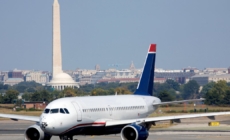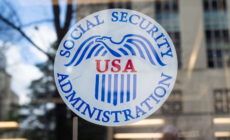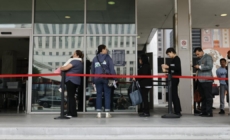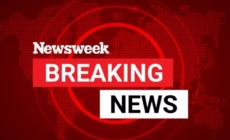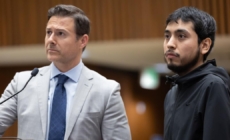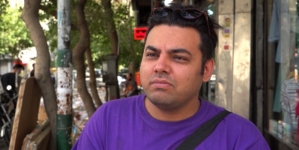-
Military parade in Washington, D.C., could disrupt flights at Reagan National Airport - 4 mins ago
-
Americans Filing for Social Security Surges to Record High Amid Cut Fears - 15 mins ago
-
With Aaron Rodgers, where do Steelers stand in AFC pecking order? - 18 mins ago
-
Torrance boy, 9, detained by ICE for planned deportation to Honduras; community outraged - 34 mins ago
-
Florida man convicted in 2004 cold case death of victim whose remains have not been found - 45 mins ago
-
‘Cheers’ actor George Wendt’s death linked to heart conditions - 47 mins ago
-
Musk On If Trump Should Be Impeached: ‘Yes’ - 54 mins ago
-
FOX Super 6 contest: Chris ‘The Bear’ Fallica’s Belmont Stakes picks - about 1 hour ago
-
Prison for Instagram? L.A. authorities target street racing influencer - about 1 hour ago
-
Tesla stock price plunges as Trump suggests stripping Elon Musk’s companies of federal contracts - about 1 hour ago
Woman Tries To Pay Virginia Students’ School Lunch Debts—then Learns amount
A woman looking to settle the lunch debt of students from two middle schools in Virginia was surprised to discover the total amount she would be required to pay.
School lunch debt is a major source of concern in the U.S. According to the Education Data Initiative. Data updated in November last year on School Lunch Debt Statistics showed 20.1 million students receive a free or reduced-price lunch. The report highlighted the current national public school meal debt, which stands at $176 million a year, equating to an average meal debt per child of $537.
It’s a nationwide issue, with an estimated 68.8 percent of schools surveyed by the Education Data Initiative reporting they have unpaid student meal debt. And some 87 percent of surveyed school districts also reported seeing an annual increase in the number of students unable to afford meals.
For the past two years, Sarah Stusek, the owner of content production company Stusek Studios, who is based in Virginia, has been working as part of the Proper Help Foundation to address an issue that is impacting many families.
“Some parents aren’t able to afford school lunch or they simply haven’t applied for free or reduced school lunch or they have but it has been coded wrong in the system,” Stusek told Newsweek.
TikTok/sarahshooots
“Some schools do keep giving kids food regardless, but some places feed them something different like a cold sandwich or nothing at all. A lot of times kids are held back from field trips, graduations and other school sponsored activities due to the debt they owe.”
She estimates that the foundation has paid off over $10,000 in school lunch debt over the past two years. Stusek’s efforts were documented in a previous Newsweek story which saw her visit the Mount Vernon Community School in Alexandria, Virginia after being tipped off, to settle $1,659.70 in unpaid school lunch debt.
Things don’t always go so smoothly though, as Stusek discovered while attempting to pay off the debts associated with another couple of students in the same Alexandria city public school district.
In a video posted to her TikTok account, @sarahshooots, which amassed more than 235,000 views since being shared last month, Stusek can be seen attempting to settle the accounts of a couple of students she was told “needed help” paying off their lunch debts.
Stusek is connected to no fewer than four different people during her call with the school district. On the video, she explains that she originally called up with the intention of paying off the debts of pupils at two schools in the district but, according to what she states on the video, discovered “you can’t do the whole school anymore, they only have one pot of debt for the whole entire district.”
That total debt stood at $29,720.36, which was far beyond what Stusek was capable of paying that day. Stusek said had been expecting to pay a maximum of around $2,000 which is the most she has seen for an individual school.
Stusek is not sure why the system is the way it is but felt it “definitely makes it harder to help.” She said: “It covers 18 schools so not terrible but the lump sum makes it seem so far away.”
When asked about how the system for paying off school lunch debt in the district works, the Director of Food & Nutrition Services Dr. Eric Coleman told Newsweek: “Donations to Alexandria City Public Schools (ACPS) are made through our official donor website, where contributors are requested to specify how they would like their donation to be used. Once a donation is submitted, the Office of Community Partnerships & Engagement follows up with the donor within three business days to discuss next steps.
“It’s important to note that when a donor designates a specific school, department or program to receive their contribution, it is classified as a ‘restricted donation’ rather than a ‘disbursement condition, as outlined in the ACPS donation policy.
“Per School Board policy, any donation with an estimated value of $5,000 or more, or any donation that includes disbursement conditions, must be formally accepted by a vote during a School Board meeting. Donations under $5,000 without disbursement conditions may be accepted by the superintendent or the executive director of community partnerships & engagement.
“Additionally, the School Board, superintendent or the executive director of community partnerships & engagement reserve the right to place reasonable conditions or limitations on donations offered to the school division and its allocation. Donations are able to be accepted online by credit card or by sending in a check and money order. For additional information and details on how to donate, please visit the ACPS Donate webpage.”
Stusek has not given up on settling the debt and would encourage anyone eager to help to visit the Proper Help Foundation website for information on how to do so.
In the meantime, she is working on assisting with a number of other parents and students seeking help across the U.S.
“I have gotten about 15,000 in additional inquiries from people who also need help paying off their debt including 5,000 from a school close to me in Prince George’s County in Maryland and $500 from a single second grade student at a private school all the way in Lafayette, Louisiana.”
Source link
